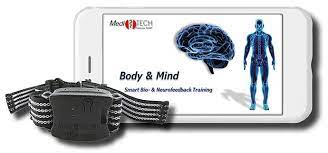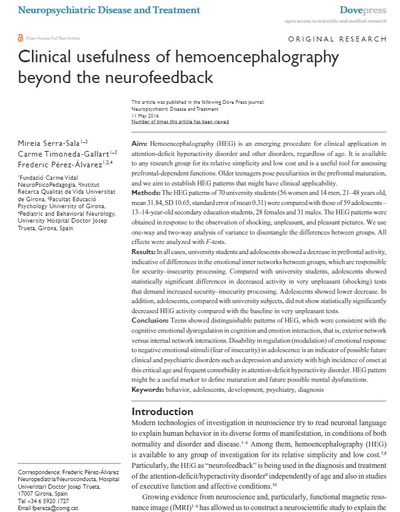
HEG Neurofeedback info channel
Here you will find basic information about HEG neurofeedback. This is a procedure for self-regulation. Unlike conventional EEG neurofeedback, which requires a high degree of self-discipline and especially "sitting still" from the trainee, HEG is extremely easy to use, does not require any pre- and post-processing and is easy for the trainee to understand in its feedback effect.
| Responsible | Ralph Warnke |
|---|---|
| Last Update | 08/13/2024 |
| Completion Time | 1 day 1 hour 35 minutes |
| Mitglieder | 11 |
Share This Course
Share Link
Share on Social Media
Share by Email
Please login to share this HEG Neurofeedback info channel by email.

Aim: Hemoencephalography (HEG) is an emerging procedure for clinical application in attention-deficit hyperactivity disorder and other disorders, regardless of age. It is available to any research group for its relative simplicity and low cost and is a useful tool for assessing prefrontal-dependent functions. Older teenagers pose peculiarities in the prefrontal maturation, and we aim to establish HEG patterns that might have clinical applicability. Methods: The HEG patterns of 70 university students (56 women and 14 men, 21-48 years old, mean 31.84, SD 10.65, standard error of mean 0.31) were compared with those of 59 adolescents - 13-14-year-old secondary education students, 28 females and 31 males. The HEG patterns were obtained in response to the observation of shocking, unpleasant, and pleasant pictures. We use one-way and two-way analysis of variance to disentangle the differences between groups. All effects were analyzed with F-tests. Results: In all cases, university students and adolescents showed a decrease in prefrontal activity, indicative of differences in the emotional inner networks between groups, which are responsible for security-insecurity processing. Compared with university students, adolescents showed statistically significant differences in decreased activity in very unpleasant (shocking) tests that demand increased security-insecurity processing. Adolescents showed lower decrease. In addition, adolescents, compared with university subjects, did not show statistically significantly decreased HEG activity compared with the baseline in very unpleasant tests. Conclusion: Teens showed distinguishable patterns of HEG, which were consistent with the cognitive emotional dysregulation in cognition and emotion interaction, that is, exterior network versus internal network interactions. Disability in regulation (modulation) of emotional response to negative emotional stimuli (fear of insecurity) in adolescence is an indicator of possible future clinical and psychiatric disorders such as depression and anxiety with high incidence of onset at this critical age and frequent comorbidity in attention-deficit hyperactivity disorder. HEG pattern might be a useful marker to define maturation and future possible mental dysfunctions.
Publikationen
View allAim: Hemoencephalography (HEG) is an emerging procedure for clinical application in attention-deficit hyperactivity disorder and other disorders, regardless of age. It is available to any research group for its relative simplicity and low cost and is a useful tool for assessing prefrontal-dependent functions. Older teenagers pose peculiarities in the prefrontal maturation, and we aim to establish HEG patterns that might have clinical applicability. Methods: The HEG patterns of 70 university students (56 women and 14 men, 21-48 years old, mean 31.84, SD 10.65, standard error of mean 0.31) were compared with those of 59 adolescents - 13-14-year-old secondary education students, 28 females and 31 males. The HEG patterns were obtained in response to the observation of shocking, unpleasant, and pleasant pictures. We use one-way and two-way analysis of variance to disentangle the differences between groups. All effects were analyzed with F-tests. Results: In all cases, university students and adolescents showed a decrease in prefrontal activity, indicative of differences in the emotional inner networks between groups, which are responsible for security-insecurity processing. Compared with university students, adolescents showed statistically significant differences in decreased activity in very unpleasant (shocking) tests that demand increased security-insecurity processing. Adolescents showed lower decrease. In addition, adolescents, compared with university subjects, did not show statistically significantly decreased HEG activity compared with the baseline in very unpleasant tests. Conclusion: Teens showed distinguishable patterns of HEG, which were consistent with the cognitive emotional dysregulation in cognition and emotion interaction, that is, exterior network versus internal network interactions. Disability in regulation (modulation) of emotional response to negative emotional stimuli (fear of insecurity) in adolescence is an indicator of possible future clinical and psychiatric disorders such as depression and anxiety with high incidence of onset at this critical age and frequent comorbidity in attention-deficit hyperactivity disorder. HEG pattern might be a useful marker to define maturation and future possible mental dysfunctions.
OPEN ACCESS
Background: The effects of electroencephalography (EEG) and functional magnetic
resonance imaging (fMRI)-neurofeedback on brain activation and behaviors have
been studied extensively in the past. More recently, researchers have begun to
investigate the effects of functional near-infrared spectroscopy-based neurofeedback
(fNIRS-neurofeedback). FNIRS is a functional neuroimaging technique based on brain
hemodynamics, which is easy to use, portable, inexpensive, and has reduced sensitivity
to movement artifacts.
Method: We provide the first systematic review and database of fNIRS-neurofeedback
studies, synthesizing findings from 22 peer-reviewed studies (including a total of N = 441
participants; 337 healthy, 104 patients). We (1) give a comprehensive overview of
how fNIRS-neurofeedback training protocols were implemented, (2) review the online
signal-processing methods used, (3) evaluate the quality of studies using pre-set
methodological and reporting quality criteria and also present statistical sensitivity/power
analyses, (4) investigate the effectiveness of fNIRS-neurofeedback in modulating
brain activation, and (5) review its effectiveness in changing behavior in healthy and
pathological populations.